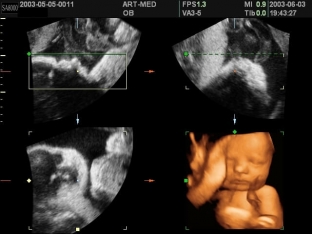Multiple pregnancy – this is always a huge risk for both the expectant mother and the fetus. Such a pregnancy is very often complicated, dangerous situations can also arise during childbirth or in the postpartum period. But, perhaps, one of the biggest fears of doctors in multiple pregnancies is the development of various kinds of intrauterine pathologies. As you know, in pathological multiple pregnancy, congenital malformations are diagnosed much more often than in physiological singleton. Feto-fetal transfusion syndrome is a dangerous complication in about 20% of pregnancies with monozygotic twins.
Feto-fetal transfusion syndrome in multiple pregnancies
Feto-fetal transfusion syndrome leads to perinatal mortality in at least 60% of cases. This dangerous condition is due to the presence of anastomosing vessels between the two fetal circulatory systems. In most cases, anastomoses are located in the thickness of the placenta. The complication is often found in identical twins with a monochorionic placenta, while in identical twins with a bichorionic placenta, the occurrence of this complication is much less common. The severity of the pathology depends on the intensity of the redistribution of blood between the fetuses through the anastomoses, which can be located in different directions, and be of different sizes and in different quantities.
Feto-fetal transfusion:
- diagnosis of feto-fetal transfusion syndrome;
- treatment of feto-fetal transfusion syndrome;
- reverse perfusion in feto-fetal transfusion syndrome.
Diagnosis of feto-fetal transfusion syndrome
In feto-fetal transfusion syndrome, one of the fetuses is a donor fetus, and the other – recipient fetus.
At the background of placental insufficiency due to blood loss and hypoxia, the donor fetus develops hypovolemia, and the recipient fetus suffers from heart failure resulting from hypervolemia. Ultrasound examination makes it possible to diagnose the syndrome of feto-fetal blood transfusion. The specific features of this syndrome are the following echographic data:
- severe polyhydramnios and large bladder with polyuria in the recipient fetus;
- almost complete "absence" bladder and anuria in the donor fetus.

Treatment of feto-fetal transfusion syndrome
The only effective treatment for feto-fetal transfusion syndrome is sonoendoscopic technique.
Under echographic control, endoscopic laser coagulation of the anastomosing vessels of the placenta is performed. With the help of endoscopic laser coagulation, it is possible to prolong pregnancy by about 14 weeks, while the probability of intrauterine death of at least one of the fetuses is several times reduced. If it is not possible to carry out laser coagulation of the anastomosing vessels of the placenta, an excess amount of amniotic fluid is drained from the amniotic cavity of the recipient fetus. Such treatment can be carried out repeatedly during the entire period of pregnancy.
Reverse perfusion in feto-fetal transfusion syndrome
Reverse arterial perfusion is the second variant of the feto-fetal transfusion syndrome. With this pathology, there is a violation of vascular perfusion, as a result of which the recipient fetus develops at the expense of the donor fetus through umbilical arterio-arterial anastomoses. At the same time, structural anomalies are often not detected in the donor fetus, but signs of dropsy are observed. At the same time, the recipient fetus, which parasitizes, is diagnosed with multiple anomalies that are incompatible with life: it may have no heart and head, or serious defects in these organs, for example, rudimentary & nbsp; heart. For the donor fetus, the prognosis is also unfavorable: ligation of the umbilical cord of the recipient fetus is the only way to save the life of the donor fetus.







Add a comment